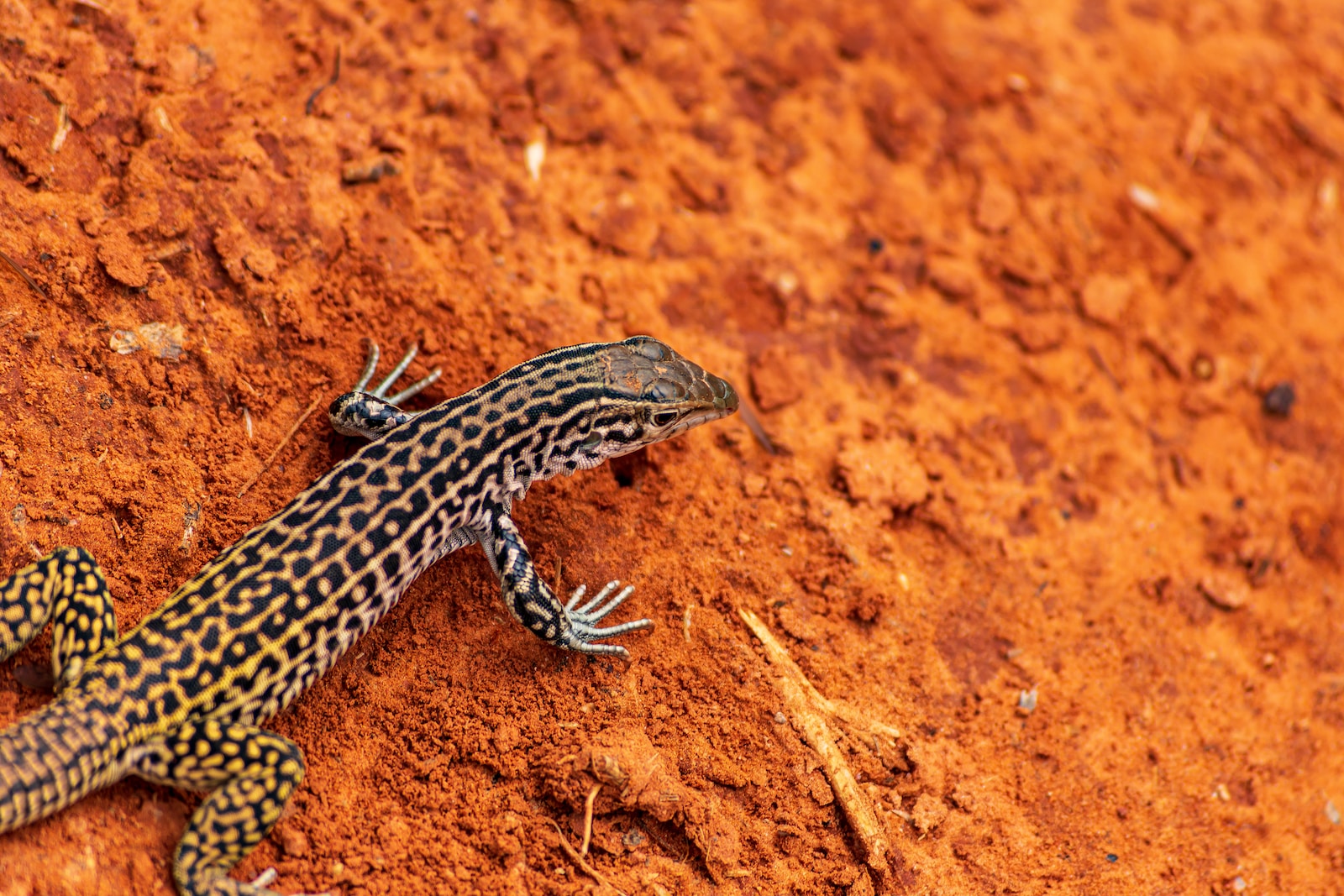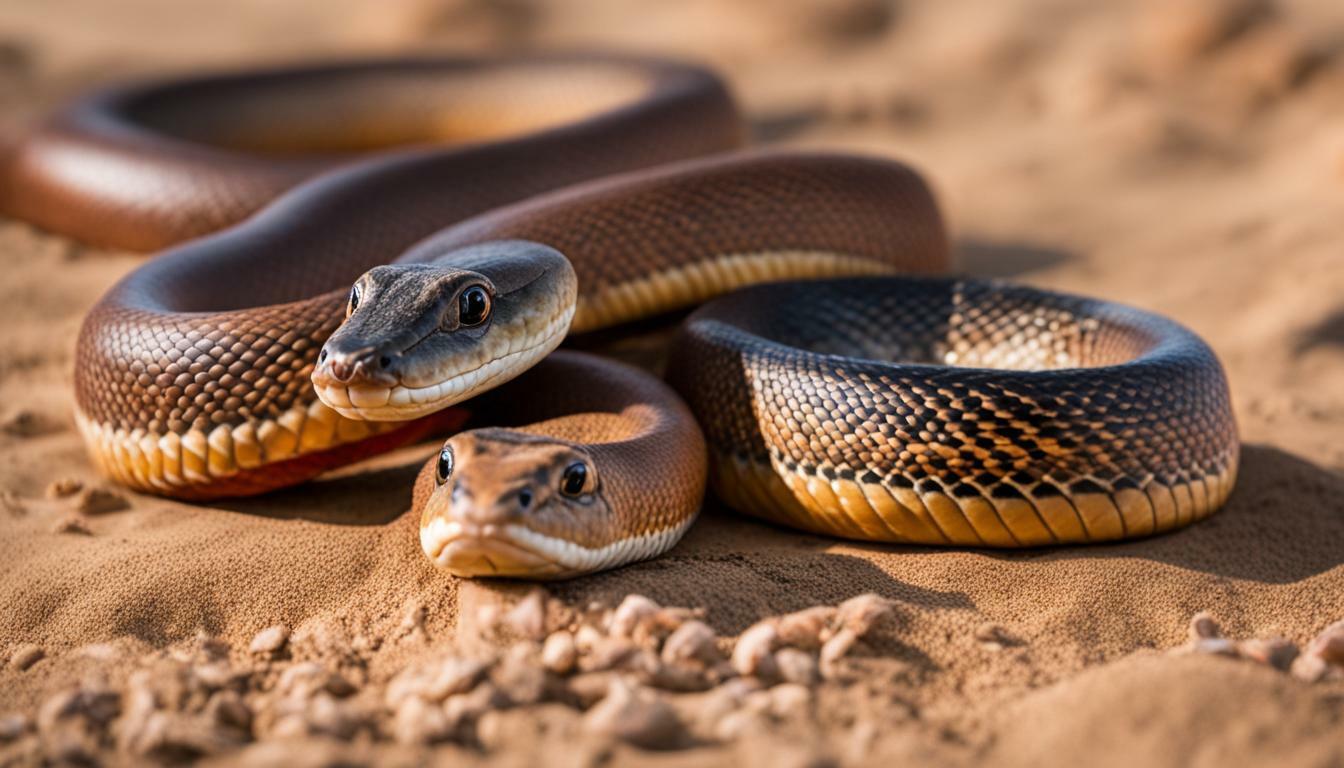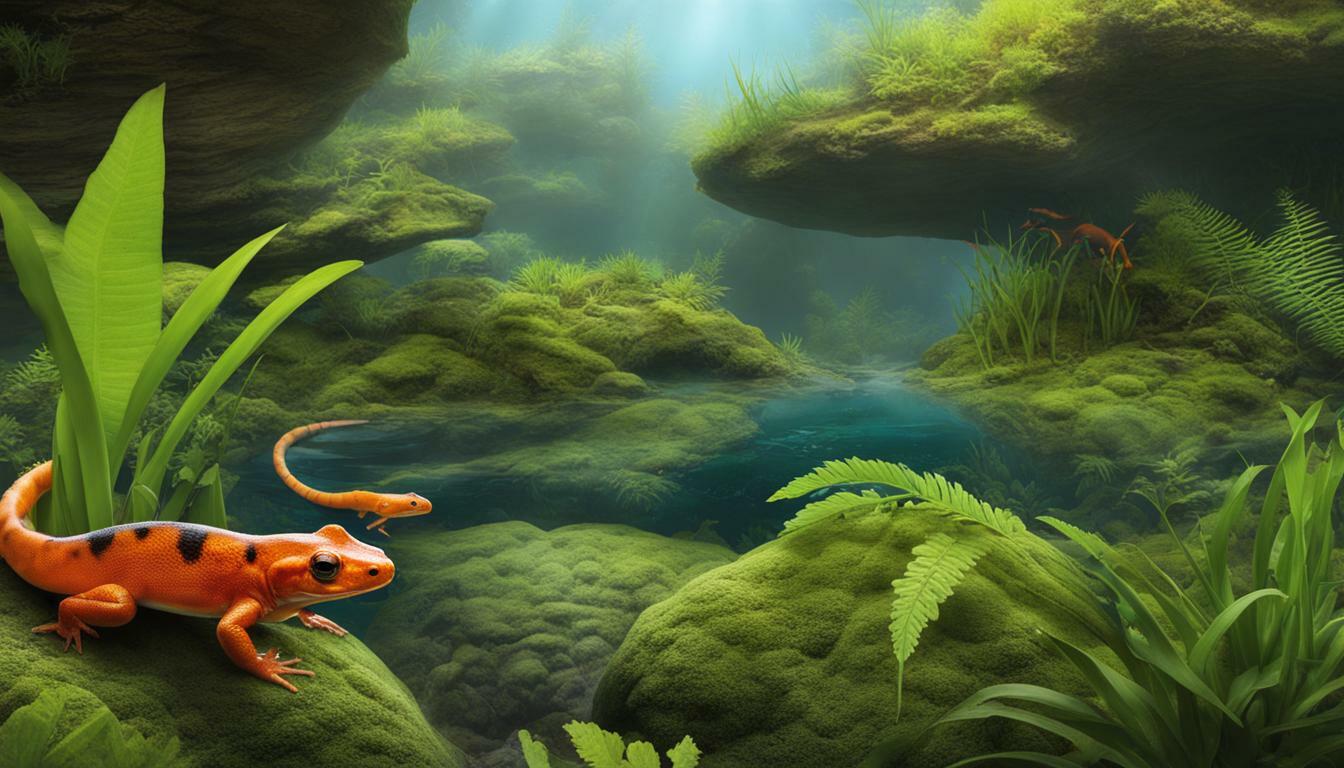Leopard geckos and crested geckos are both popular choices for pet owners looking for a reptilian companion. While they share some similarities, they also have distinct characteristics that set them apart from each other. In this article, we will compare and contrast leopard geckos and crested geckos, exploring their differences in appearance, habitat, behavior, diet, and more.
Key Takeaways:
- Leopard geckos and crested geckos are both popular choices for reptile pet owners.
- They have distinct characteristics that differentiate them from each other.
- Understanding their differences can help you choose the right gecko species for you.
Leopard Gecko Characteristics
Leopard geckos are a fascinating gecko species with unique characteristics that set them apart from other gecko species. Here are some of the key leopard gecko characteristics:
- Appearance: Leopard geckos are named for their striking spotted patterns resembling a leopard’s coat. Their coloration varies, from yellow to white, orange, and even black. Adult leopard geckos can grow up to 8-10 inches long.
- Docile Nature: Leopard geckos are known for their gentle and friendly nature, making them an excellent choice for first-time reptile owners.
- Nocturnal: These geckos are active at night, spending their days sleeping or hiding in their burrows or other hiding places.
- Easily Tamed: Leopard geckos can be easily tamed and handled, and they rarely bite.
Leopard geckos are relatively easy to care for, but there are a few tips to keep in mind:
- Enclosure: A 20-gallon tank is suitable for one or two adult leopard geckos. The tank should be equipped with a heat lamp, a UVB light, and plenty of hiding places. The substrate should be reptile carpet or paper towels to make it easy to clean.
- Temperature: The basking spot should be kept at 90-95°F, and the cool side of the tank should be around 75°F. A temperature gradient is essential for leopard geckos to regulate their body temperature.
- Diet: Leopard geckos are insectivores and should be fed a diet of crickets, mealworms, and occasional waxworms. Feed them every other day, and make sure to dust their food with calcium and vitamin D3 supplements.
Leopard Gecko Health Concerns
Leopard geckos are generally healthy and hardy, but there are a few health concerns to watch out for:
- Metabolic Bone Disease: This condition is caused by a lack of proper nutrition and UVB light. It can lead to weak bones, deformities, and even death.
- Respiratory Infections: Leopard geckos are susceptible to respiratory infections, which can be caused by inadequate temperatures, humidity, and poor ventilation.
- Parasites: Geckos can develop internal and external parasites, which can lead to weight loss, lethargy, and other health issues. Regular check-ups with a veterinarian can help prevent and treat parasites.
By understanding leopard gecko characteristics and providing proper care, you can enjoy a rewarding experience as a gecko owner.
Crested Gecko Characteristics
Crested geckos, also known as eyelash geckos, are a popular species of gecko that have gained popularity as pets over the years. They are native to New Caledonia, a group of islands located in the Pacific Ocean.
Crested geckos have a distinctive appearance, with their vibrant colors and striking crests that run from their heads to their tails. They can come in a variety of colors, including brown, green, orange, and red, making them a popular choice among gecko enthusiasts. They also have skin that feels soft and velvety to the touch.
One unique characteristic that sets crested geckos apart from other gecko species is their remarkable ability to climb. Their feet have special pads that allow them to stick to surfaces, enabling them to climb trees and other vertical objects with ease.
When it comes to temperament, crested geckos are generally docile and friendly. They are known to be more active at night, making them a great option for those who are looking for a pet that is more active in the evenings. They can also be easily handled, making them a popular choice among pet owners.
Crested Gecko Care Guide
If you are considering a crested gecko as a pet, it is important to provide the right care to ensure their well-being. Below are some care tips to help you create an ideal habitat for your crested gecko:
- Enclosure: Choose an enclosure that is at least 20 gallons for one adult crested gecko. The enclosure should be taller than it is wide to provide ample climbing space for your gecko.
- Temperature and Humidity: Crested geckos thrive in a temperature range of 72-80° F and a humidity level of 50-80%. You can maintain humidity levels by misting the enclosure with water daily.
- Diet: Crested geckos are omnivores, meaning they eat both insects and fruit. Feed them a diet consisting of gut-loaded insects and Repashy crested gecko diet to ensure they get the proper nutrients they need.
- Handling: Crested geckos are generally easy to handle. However, it is important to handle them gently and avoid grabbing their tails, as their tails can detach if they feel threatened.
By following these care tips, you can ensure that your crested gecko is healthy, happy, and thriving in their new home.
Habitat and Environment
Providing a suitable environment is crucial in ensuring your gecko’s well-being. The habitat requirements for leopard geckos and crested geckos have some key differences that are important to consider when choosing the right gecko species for your home.
Leopard Gecko Care Tips: Leopard geckos are native to arid regions and require a warm and dry environment. The ideal temperature range is between 88-93°F during the day and around 70-75°F at night. A gradient should be provided in the enclosure to allow your gecko to regulate their body temperature. The humidity level should be kept low, around 30-40%. A 20-gallon tank is sufficient for one gecko, but larger enclosures are recommended if housing multiple geckos. Provide hiding spots, such as rocks or logs, and a shallow water dish for drinking and soaking.
Crested Gecko Care Guide: Crested geckos are native to tropical forests and require a slightly cooler and more humid environment than leopard geckos. The ideal temperature range is between 72-78°F during the day and around 65-72°F at night. The humidity level should be high, around 60-80%. A 20-gallon tank is recommended for one gecko, with larger enclosures needed if housing multiple geckos. Provide plenty of plants, branches, and other climbing materials to allow your gecko to exercise and explore their surroundings. A water dish should be provided for drinking and soaking.
When choosing a gecko species, consider your ability to maintain their habitat’s specific needs. A gecko’s health and well-being depend on the proper temperature, humidity, lighting, and enclosure setup.
Behavior and Temperament
While both leopard geckos and crested geckos can make great pets, they have different personalities and behaviors.
Leopard geckos are generally docile and friendly, making them a great choice for beginners. They are solitary and prefer to live alone, and may become stressed if housed with other geckos. Leopard geckos are also relatively inactive during the day and prefer to sleep, but become more active at night. They may tolerate handling, but it’s important to be gentle and avoid picking them up by the tail, which can break off and cause injury.
Crested geckos, on the other hand, are more active during the day and enjoy climbing and jumping. They are social creatures and can be housed together, as long as there is enough space and hiding places for each gecko. Crested geckos also have the ability to regenerate their tails if they become injured, which is a unique trait. They may be more sensitive to handling than leopard geckos, and it’s important to support their body and avoid excessive stress.
Understanding the behavior and temperament of your gecko is essential for creating a comfortable and supportive environment. By providing appropriate socialization and interaction, you can ensure the happiness and well-being of your gecko.
Diet and Feeding
Proper nutrition is essential for the overall health and well-being of your gecko. Both leopard geckos and crested geckos have specific dietary requirements that you should be aware of.
Leopard Gecko Diet
Leopard geckos are insectivores, meaning they primarily eat insects. Some of their favorite food includes crickets, mealworms, and waxworms. It is important to vary their diet to ensure they receive a balanced intake of nutrients. You can also offer them occasional treats such as fruit or vegetables.
When feeding your leopard gecko, it’s best to offer small amounts of food at a time to prevent overfeeding. Babies and juveniles should be fed more frequently than adults, with daily feedings being ideal. Adult leopard geckos can be fed every two to three days.
Crested Gecko Diet
Crested geckos have a diverse diet that includes insects, fruit, and nectar. Some of their favorite insects include crickets, roaches, and mealworms. They also enjoy mashed fruit such as bananas, mangoes, and papayas. Additionally, you can offer them a commercial crested gecko diet, which is a convenient and healthy option.
Crested geckos should be fed every other day, with juveniles needing more frequent feedings. Their diet should be supplemented with calcium powder to ensure proper bone development and overall health.
Feeding Tips
Regardless of the species, it’s important to provide your gecko with fresh food and water daily. Avoid feeding them insects that are too big, as this can cause digestive problems. It’s also important to dust their food with calcium powder to prevent calcium deficiencies. Finally, monitor your gecko’s weight to ensure they are not over or underfed.
By providing a nutritious and balanced diet, you can ensure your gecko remains healthy and thriving.
Conclusion
Choosing between a leopard gecko and a crested gecko can be a tough decision, but understanding their similarities and differences can help make the decision easier. Both species make fantastic pets and offer their own unique qualities and characteristics.
Remember to Provide Proper Care and Attention
Regardless of which gecko species you choose, it is essential to provide them with the proper care and attention they need to thrive. This includes creating a suitable habitat, maintaining proper temperature and humidity, providing a healthy diet, and giving them the attention and interaction they crave.
Thank You for Joining Us on This Adventure
We hope this comparison of leopard geckos and crested geckos has been helpful and informative, and we wish you the best of luck in your gecko ownership journey. Remember to always seek professional advice if you have any questions or concerns about your gecko’s well-being, and enjoy the unique companionship that these fantastic creatures can offer.
FAQ
Q: What are the key differences between leopard geckos and crested geckos?
A: Leopard geckos and crested geckos have distinct characteristics that set them apart. Leopard geckos have spotted patterns and come in various colors, while crested geckos have vibrant colors and striking crests. Additionally, leopard geckos are known for their docile and friendly nature, while crested geckos have remarkable climbing abilities.
Q: What care tips should I know for leopard geckos?
A: Leopard geckos require a suitable habitat with proper temperature and lighting. They should be fed a diet consisting of live insects and supplemented with calcium. Regular handling and social interaction are also important for their well-being.
Q: What care guide should I follow for crested geckos?
A: Crested geckos need a habitat with sufficient humidity levels and climbing opportunities. Their diet mainly consists of fruit-based powdered meal replacements. They are generally less tolerant of handling and prefer observing from a distance.
Q: How should I set up the habitat for my gecko?
A: Leopard geckos require a warm and dry environment with a temperature gradient within their enclosure. Providing hiding spots, a suitable substrate, and a shallow water dish is essential. Crested geckos need a more humid environment with vertical spaces for climbing. Branches, vines, and hiding spots should be included in their enclosure.
Q: What are the behavior and temperament differences between leopard geckos and crested geckos?
A: Leopard geckos are known for their docile and friendly nature, making them more tolerant of handling. Crested geckos are generally more shy and prefer observing from a distance. Both species have their unique social interactions and activity levels.
Q: What should I feed my gecko?
A: Leopard geckos primarily eat live insects like crickets and mealworms, supplemented with calcium and other nutrients. Crested geckos have a diet based on powdered meal replacements that are mixed with water. A variety of fruits can also be offered occasionally.
 Skip to main content
Skip to main content


